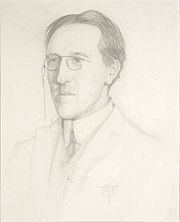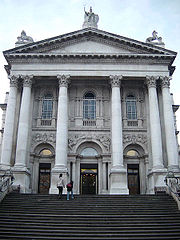
Charles Aitken
Encyclopedia

Order of the Bath
The Most Honourable Order of the Bath is a British order of chivalry founded by George I on 18 May 1725. The name derives from the elaborate mediæval ceremony for creating a knight, which involved bathing as one of its elements. The knights so created were known as Knights of the Bath...
(12 September 1869 – 9 August 1936) was a British
United Kingdom
The United Kingdom of Great Britain and Northern IrelandIn the United Kingdom and Dependencies, other languages have been officially recognised as legitimate autochthonous languages under the European Charter for Regional or Minority Languages...
art administrator and was the third Keeper of the Tate Gallery
Tate Gallery
The Tate is an institution that houses the United Kingdom's national collection of British Art, and International Modern and Contemporary Art...
(1911–1917) and the first Director (1917–1930).
Life and work
Charles Aitken was born at Bishophill, Bishophill Junior, YorkYork
York is a walled city, situated at the confluence of the Rivers Ouse and Foss in North Yorkshire, England. The city has a rich heritage and has provided the backdrop to major political events throughout much of its two millennia of existence...
, England
England
England is a country that is part of the United Kingdom. It shares land borders with Scotland to the north and Wales to the west; the Irish Sea is to the north west, the Celtic Sea to the south west, with the North Sea to the east and the English Channel to the south separating it from continental...
, the son of Henry Martin Aitken, a surgical instrument manufacturer, and his wife, Elizabeth Atkinson. Aitken studied at New College, Oxford
New College, Oxford
New College is one of the constituent colleges of the University of Oxford in the United Kingdom.- Overview :The College's official name, College of St Mary, is the same as that of the older Oriel College; hence, it has been referred to as the "New College of St Mary", and is now almost always...
.
He was the first Director of the Whitechapel Art Gallery from 1901 to 1911, and became Keeper at the Tate Gallery in 1911. In 1917 he changed his title from "Keeper" to "Director". Sir John Rothenstein
John Rothenstein
Sir John Knewstub Maurice Rothenstein CBE was an English art historian. He grew up in London the son of Sir William Rothenstein. The family was loosely connected to the Bloomsbury Set. John Rothenstein studied at Oxford University and became friends with T. E. Lawrence...
described Aitken as "an ordinary man: his intelligence was relatively pedestrian, his powers of self-expression scarcely adequate". However, Rothenstein considered that the job "brought out qualities that made him a great director: clarity and firmness of purpose".

William Blake
William Blake was an English poet, painter, and printmaker. Largely unrecognised during his lifetime, Blake is now considered a seminal figure in the history of both the poetry and visual arts of the Romantic Age...
came on the open market, Aitken, who had no purchasing budget, put together a consortium to save it. Because of the problems caused by dark or foggy days, when the public could not see the artwork by natural light and attendants cleared the galleries due to the difficulty of proper surveillance, Aitken decided to install electric lighting. He also introduced the sale of prints, photographs and catalogues of the Collection.
After Aitken commissioned Rex Whistler
Rex Whistler
Reginald John 'Rex' Whistler was a British artist, designer and illustrator.-Biography:Rex Whistler was born in Eltham, Kent, the son of Henry and Helen Frances Mary Whistler...
to decorate the Tate's Refreshment Room with a mural, he persuaded Sir Joseph Duveen, an influential art dealer, to finance a similar scheme. Having chosen Morley College
Morley College
Morley College is an adult education college in London, England. It was founded in the 1880s and has a student population of 10,806 adult students...
in London
London
London is the capital city of :England and the :United Kingdom, the largest metropolitan area in the United Kingdom, and the largest urban zone in the European Union by most measures. Located on the River Thames, London has been a major settlement for two millennia, its history going back to its...
for the location of the new mural, Aitken and Duveen invited William Rothenstein
William Rothenstein
Sir William Rothenstein was an English painter, draughtsman and writer on art.-Life and work:William Rothenstein was born into a German-Jewish family in Bradford, West Yorkshire. His father, Moritz, emigrated from Germany in 1859 to work in Bradford's burgeoning textile industry...
, the Principal of the Royal College of Art
Royal College of Art
The Royal College of Art is an art school located in London, United Kingdom. It is the world’s only wholly postgraduate university of art and design, offering the degrees of Master of Arts , Master of Philosophy and Doctor of Philosophy...
, to submit the names and designs of six young students and ex-students to design the mural. The three chosen students were Edward Bawden
Edward Bawden
Edward Bawden, CBE, RA was a British painter, illustrator and graphic artist. He was also famous for his prints, book covers, posters, and garden metalwork furniture...
, Eric Ravilious
Eric Ravilious
Eric William Ravilious was an English painter, designer, book illustrator and wood engraver.-Career:Ravilious studied at Eastbourne School of Art, and at the Royal College of Art, where he studied under Paul Nash and became close friends with Edward Bawden.He began his working life as a muralist,...
and Cyril Mahoney. The mural took them a total of two years to complete.
When the art critic of The Daily Telegraph
The Daily Telegraph
The Daily Telegraph is a daily morning broadsheet newspaper distributed throughout the United Kingdom and internationally. The newspaper was founded by Arthur B...
wrote an article claiming that the sculptures of Jacob Epstein
Jacob Epstein
Sir Jacob Epstein KBE was an American-born British sculptor who helped pioneer modern sculpture. He was born in the United States, and moved to Europe in 1902, becoming a British citizen in 1911. He often produced controversial works which challenged taboos on what was appropriate subject matter...
had been universally condemned by critics, Epstein wrote instancing the support of Aitken among other leading names in the art world. In 1909 Aitken co-founded the Modern Art Association, which in 1910 was renamed the Contemporary Art Society.
Following his retirement from the position of Director in 1930, he was appointed a Companion of the Order of the Bath (CB) in the 1931 King's Birthday Honours. He died on 9 August 1936.
External links
- Portraits of Aitken in the National Portrait Gallery
- Aitken's retirement in the National Archives
- http://special.lib.gla.ac.uk/manuscripts/search/resultsn.cfm?NID=491&RID=Aitken in the University of GlasgowUniversity of GlasgowThe University of Glasgow is the fourth-oldest university in the English-speaking world and one of Scotland's four ancient universities. Located in Glasgow, the university was founded in 1451 and is presently one of seventeen British higher education institutions ranked amongst the top 100 of the...
Manuscript Collection]

